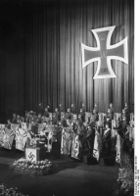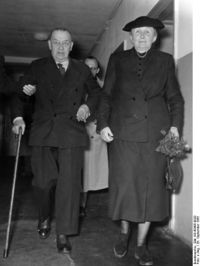Erich Raeder
| Erich Johann Albert Raeder | |
|---|---|
| 24 April 1876 – 6 November 1960 (aged 84) | |
 Großadmiral Erich Raeder |
|
| Place of birth | Wandsbek |
| Place of death | Kiel |
| Allegiance | German Empire (to 1918) Weimar Republic (to 1933) Nazi Germany |
| Years of service | 1894-1943 |
| Rank | Großadmiral |
| Battles/wars |
|
| Awards | Knight's Cross of the Iron Cross |
Erich Johann Albert Raeder (24 April 1876-6 November 1960) was a naval leader in Germany before and during World War II. Raeder attained the highest possible naval rank—that of Großadmiral (Grand Admiral) — in 1939, becoming the first person to hold that rank since Alfred von Tirpitz. Raeder led the Kriegsmarine (German Navy) for the first half of the war, but resigned in 1943 and was replaced by Karl Dönitz. He was sentenced to life in prison at the Nuremberg Trials, but was later released.
Contents |
Biography
Early years
Raeder was born into a middle-class family in Wandsbek in the Prussian province of Schleswig-Holstein in the German Empire. His father was a headmaster. He joined the Kaiserliche Marine (Imperial Navy) in 1894 and rapidly rose in rank, becoming Chief of Staff for Franz von Hipper in 1912. He served in this position during World War I as well as in combat posts, taking part in the Battle of Dogger Bank in 1915 and the Battle of Jutland in 1916. After the war Raeder continued to rise steadily in the navy hierarchy, becoming a Konteradmiral (Rear Admiral) in 1922 and a Vizeadmiral (Vice Admiral) in 1925. In October 1928 Raeder was promoted to Admiral and made Commander-in-Chief of the Reichsmarine, the Weimar Republic Navy (Oberbefehlshaber der Reichsmarine).
Although he generally disliked the Nazi Party, he strongly supported Adolf Hitler's attempt to rebuild the Kriegsmarine, while apparently disagreeing equally strongly on most other matters. On 20 April 1936, just a few days before Raeder's 60th birthday, Hitler promoted him to Generaladmiral (General Admiral). In his quest to rebuild the German Navy, Raeder faced constant challenges from Hermann Göring's ongoing quest to build up the Luftwaffe.
World War II

He was promoted to Grand Admiral (Großadmiral) in 1939—the first to hold that rank since Alfred von Tirpitz. Later that year, he suggested invading Norway in order to secure sheltered docks out of reach of the Royal Air Force, as well as provide direct exits into the North Sea, but was strongly opposed by the German Naval Staff and "[A]t the end, Raeder agreed that the 'best' solution was preservation of the status quo."[1]
Norway was vital to Germany as a transport route for iron ore from Sweden, a supply that Britain was determined to stop. One adopted British plan was to go through Norway and occupy cities in Sweden.[2][3] An Allied invasion was ordered on March 12, and the Germans intercepted radio traffic setting March 14 as deadline for the preparation.[4] Peace in Finland interrupted the Allied plans, but Hitler became, rightly, convinced that the Allies would try again, and ordered operation Weseruebung. The new Allied plans were Wilfred and Plan R 4. The plan was to provoke a German reaction by laying mines in Norwegian waters, and once Germany showed signs of taking action UK troops would occupy Narvik, Trondheim and Bergen and launch a raid on Stavanger to destroy Sola airfield. However "the mines were not laid until the morning of 8 April, by which time the German ships were advancing up the Norwegian coast."[5]
Raeder was not a strong supporter of Operation Sealion, the planned German invasion of the United Kingdom. He felt that the war at sea could be conducted far more successfully via an indirect strategic approach, by increasing the numbers of U-boats and small surface vessels in service. This, in addition to a strategic focus on the Mediterranean theater including a strong German presence in North Africa, plus an invasion of Malta and the Middle East. He believed that capturing Gibraltar, the Canary Islands and the Suez Canal would knock the United Kingdom out of the war. For instance, Raeder once told Hitler that a major offensive against Egypt and the Suez gave Germany a chance to strike a blow that "would be more deadly to the British Empire than the capture of London!"
He argued strongly against Operation Sealion because of his doubts about a decisive German air superiority over the English Channel and the lack of regional German naval superiority. Air supremacy was a prerequisite to successfully preventing destruction of the German invasion fleet by the Royal Navy.
The invasion was postponed indefinitely due to the Luftwaffe's failure to obtain air superiority during the Battle of Britain, and the significantly greater power of the Royal Navy over the German Naval forces. Instead, the German war machine was diverted to Operation Barbarossa, the German invasion of the Soviet Union, which he vigorously opposed. He thought Hitler was so fixated on wiping out the Soviet regime that he didn't realize that a larger, global strategy could have easily tipped the balance in Germany's favor.
Resignation and retirement
A series of failed operations after that point, particularly the Battle of the Barents Sea, combined with the outstanding success of the U-boat fleet under the command of Karl Dönitz, led to his eventual demotion to the rank of Admiral Inspector of the Kriegsmarine in January 1943. Raeder offered his resignation as an apology and formally resigned from Kriegsmarine in May 1943. Karl Dönitz succeeded him in the post of Commander-in-Chief of the Navy on 30 January 1943.
Raeder was suspected of involvement in the 20 July plot, but immediately cleared himself by going to Rastenburg to personally assure Hitler of his loyalty.
After the war

After the war Raeder was sentenced to life imprisonment at the Nuremberg Trials, for waging a war of aggression, a charge arising from his planning of the German invasion of Norway.
The German defense in the Nuremberg trials in 1946 argued that Germany was "compelled to attack Norway by the need to forestall an Allied invasion and that her action was therefore preemptive", e.g. such as argued for the Anglo-Soviet invasion of Iran[6]. The German defense was referring to Plan R 4 and its predecessors. However the International Military Tribunal at Nuremberg determined that no Allied invasion was imminent, and therefore rejected the German argument that Germany was entitled to attack Norway[7].
The sentence was later reduced and, due to ill health, he was released on 26 September 1955 at 11:35 am. After his release he settled down at the Uhlandstrasse in Lippstadt, Westphalia. He later wrote an autobiography, Mein Leben, in 1957. Erich Raeder died in Kiel, on 6 November 1960.
Dates of Rank
- Seekadett' - 13 May 1895
- Fähnrich zur See - 25 October 1897
- Leutnant zur See - 1 January 1899
- Oberleutnant zur See - 9 April 1900
- Kapitänleutnant - 21 March 1905
- Korvettenkapitän - 15 April 1911
- Fregattenkapitän - 26 April 1917
- Kapitän zur See - 29 November 1919
- Konteradmiral - 1 August 1922
- Vizeadmiral - 10 September 1925
- Admiral - 1 October 1928
- Generaladmiral - 20 April 1936
- Großadmiral - 1 April 1939
Awards and decorations
- Iron Cross (1914)
- 1st Class (19 November 1914)
- 2nd Class (18 February 1915)
- Cross of Honor (9 October 1934)
- Golden Party Badge (30 January 1937)
- Order of St. Maurice and St. Lazarus Grand Cross (20 September 1937)
- Order of the Rising Sun (9 November 1937)
- Clasp to the Iron Cross (1939)
- 2nd Class
- 1st Class
- Knight's Cross of the Iron Cross
- Knight's Cross on 30 September 1939 as Großadmiral and Oberbefehlshaber der Kriegsmarine
- Order of Michael the Brave
- 3rd Class
- 2nd Class
- 1st Class
- Grand Cross to the Order of the Cross of Liberty (25 March 1942)
References
- ↑ "COMMAND DECISIONS", CENTER OF MILITARY HISTORY DEPARTMENT OF THE ARMY WASHINGTON, D.C., 2000. URL p.57,58 "During the review of Studie Nord the Naval Staff once more argued strongly against an operation in Norway. It did not believe a British occupation of Norway was imminent, and it considered a German occupation without any previous action having been taken by the British as a strategically and economically dangerous venture that would result in loss of the security afforded by the territorial waters of a neutral Norway. At the end, Raeder agreed that the 'best' solution was preservation of the status quo."
- ↑ "COMMAND DECISIONS", CENTER OF MILITARY HISTORY DEPARTMENT OF THE ARMY WASHINGTON, D.C., 2000. URL p.59 "The British plan which was adopted was more modest. While ostensibly intended to bring Allied troops to the Finnish front, it laid its main emphasis on operations in northern Norway and Sweden. The main striking force was to land at Narvik and advance along the railroad to its eastern terminus at Lulea, occupying Kiruna and Gallivare along the way. By late April two Allied brigades were to be established along that line."
- ↑ "COMMAND DECISIONS", CENTER OF MILITARY HISTORY DEPARTMENT OF THE ARMY WASHINGTON, D.C., 2000. URL p.66,67 "The British held back two divisions from France, intending to put them into the field in Norway, and planned to expand their force eventually to 100,000 men. The French intended to commit about 50,000. The British and French staffs agreed that the latter half of March would be the best time for going into Norway;"
- ↑ "COMMAND DECISIONS", CENTER OF MILITARY HISTORY DEPARTMENT OF THE ARMY WASHINGTON, D.C., 2000. URL p.67,68 "The objectives were to take Narvik, the railroad, and the Swedish ore fields;" "an intercepted radio message setting 14 March as the deadline for preparation of transport groups indicated that the Allied operation was getting under way. But another message, intercepted on the 15th, ordering the submarines to disperse revealed that the peace [in Finland] had disrupted the Allied plan."
- ↑ "COMMAND DECISIONS", CENTER OF MILITARY HISTORY DEPARTMENT OF THE ARMY WASHINGTON, D.C., 2000. URL p.68
- ↑ Myres Smith McDougal, Florentino P. Feliciano, "The international law of war: transnational coercion and world public order" p211,212
- ↑ Jus ad Bellum: Law Regulating Resort to Force
Sources
- Alexander, Bevin (2000). How Hitler Could Have Won World War II, New York: Three Rivers Press. ISBN 0-609-80844-3
- Gilbey, Joseph (2006). Kriegsmarine: Admiral Raeder's Navy - a broken dream
- Huß, Jürgen & Viohl, Armin (2003). Die Ritterkreuzträger des Eisernen Kreuzes der preußischen Provinz Schleswig-Holstein und der Freien und Hansestadt Lübeck 1939-1945. Zweibrücken, Germany: VDM Heinz Nickel. ISBN 3-925 480-79-X.
- Bird, Eugene, (1976). The loneliest man in the world, Rudolph Hess, in Spandau, London: Sphere books limited.
External links
| Military offices | ||
|---|---|---|
| Preceded by Admiral Hans Zenker |
Commander in Chief of the Reichsmarine 1928-1935 |
Succeeded by himself as Commander in Chief of the Kriegsmarine |
| Preceded by himself as Commander in Chief of the Reichsmarine |
Commander in Chief of the Kriegsmarine 1935-1943 |
Succeeded by Karl Dönitz |
| Awards and achievements | ||
| Preceded by Sir Stafford Cripps |
Cover of Time Magazine 20 April 1942 |
Succeeded by Pierre Laval |
|
|||||||||||||||
|
|||||||||||||||||||||||||||||||||||||||
|
|||||||||||||||||
|
||||||||||||||
